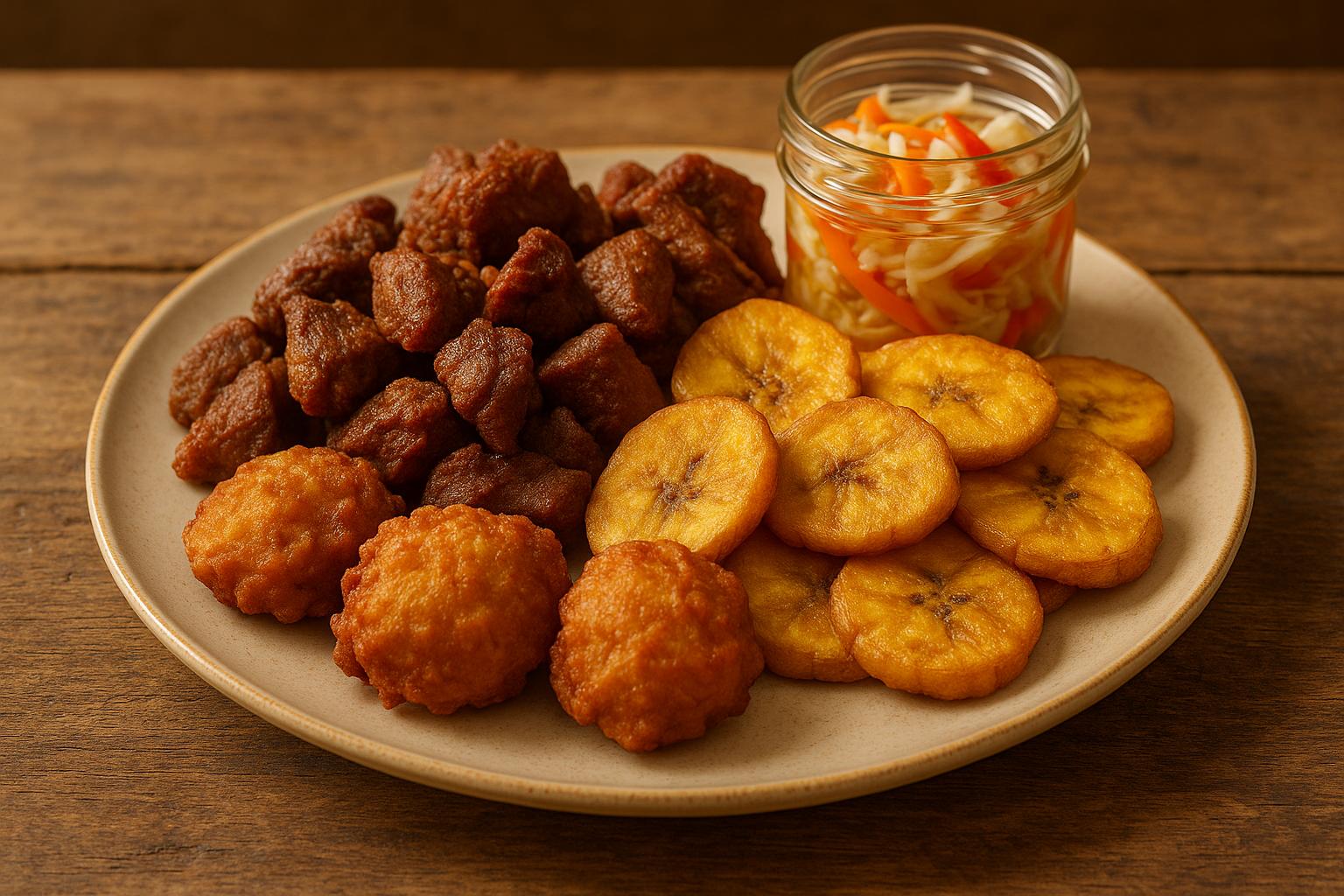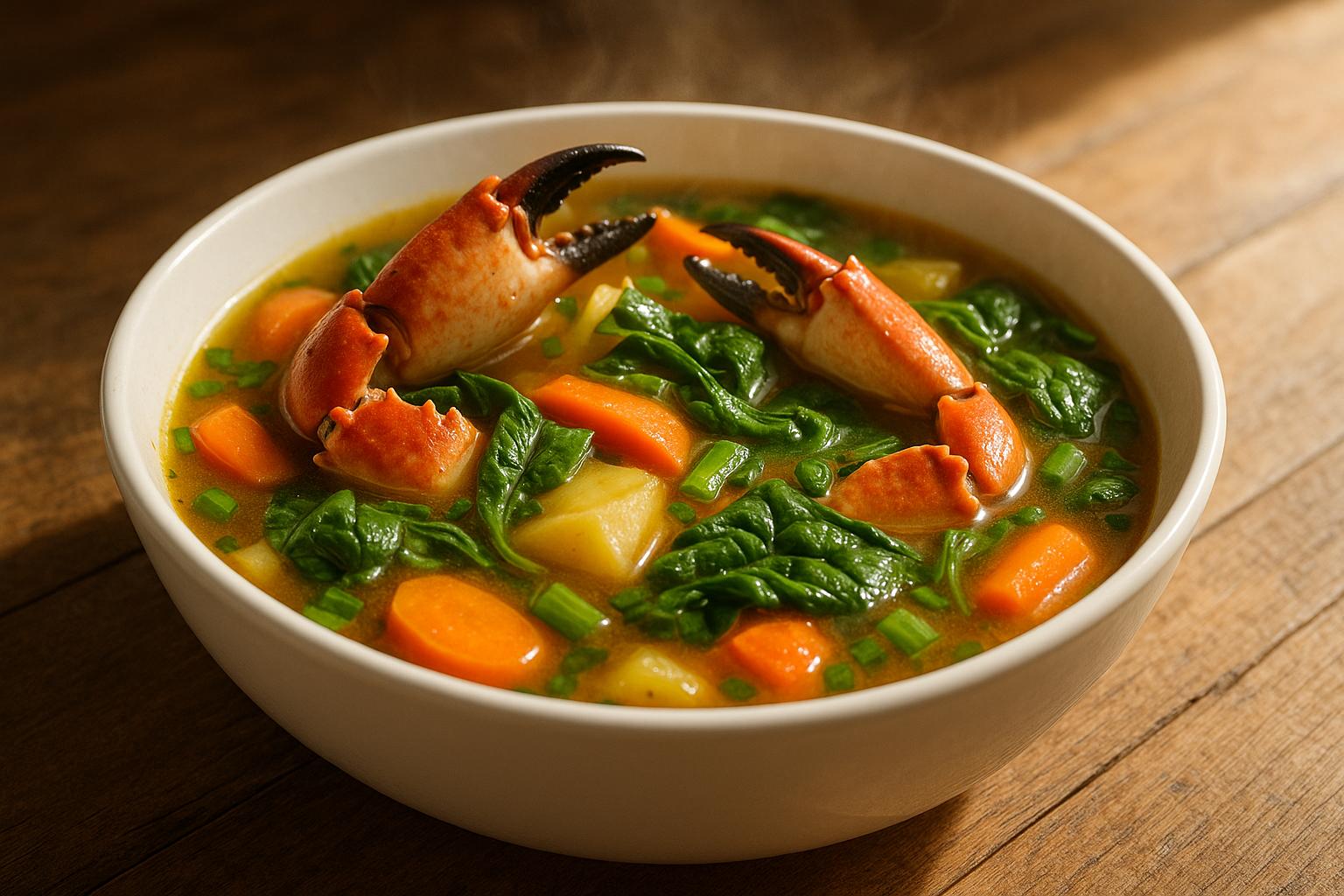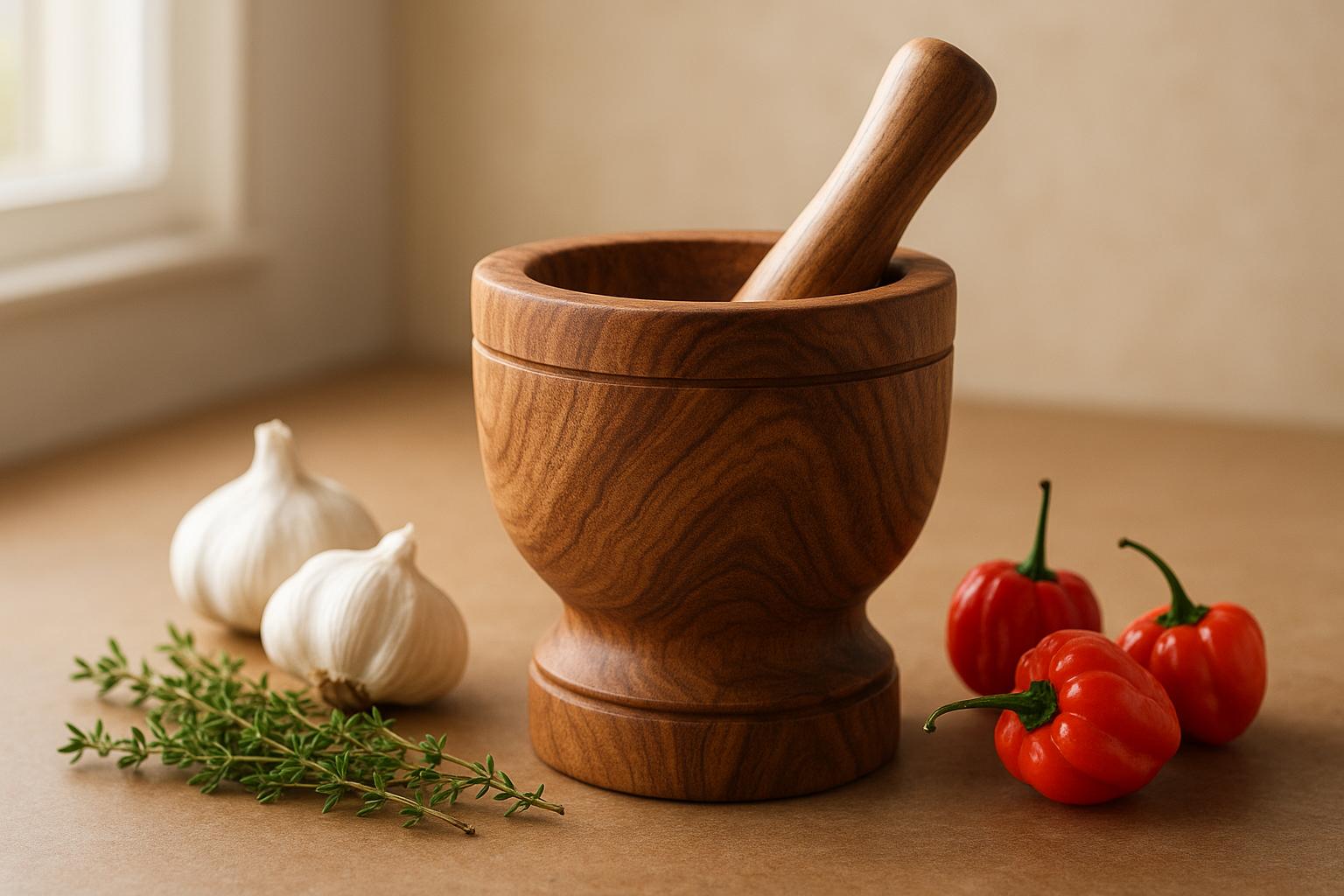Haitian epis is a flavorful seasoning blend made from vegetables, herbs, and spices. It’s the base for many Haitian dishes, from stews to marinades, and its bold flavors define the cuisine. Here's what you need to know for making epis:
- Key Ingredients: Onion, bell pepper, scallions, celery, garlic, Scotch bonnet peppers, thyme, parsley, olive oil, and lime juice. Optional additions include cilantro, cloves, or bouillon cubes.
- Preparation Tips: Chop ingredients, blend to a chunky paste, and avoid over-processing. Gradually add liquids like olive oil for the right texture.
- Storage: Refrigerate for up to 2 months or freeze in portions for 3 months.
- Uses: Marinate meats, flavor rice, soups, and stews, or experiment in non-Haitian recipes.
Epis is a concentrated seasoning, so a small amount goes a long way. It’s the key to achieving rich, layered flavors in your cooking.
Required Ingredients for Haitian Epis
Main Ingredients Checklist
Getting the ingredients just right is the secret to making authentic Haitian epis. This flavorful blend relies heavily on fresh vegetables and herbs. While recipes might vary slightly depending on personal or regional preferences, the core ingredients remain fairly consistent in most traditional preparations.
Fresh Vegetables:
- 1 large onion (about 8 oz or 225g)
- 1 large bell pepper (6–8 oz or 170–225g) – either green or red works well
- 4–6 scallions (green onions) – use both the white and green parts
- 2–3 celery stalks with leaves for added flavor
Aromatics and Spice:
- 6–8 garlic cloves – fresh bulbs are best, not pre-minced
- 1–2 Scotch bonnet peppers – adjust based on your spice tolerance
- 2–3 sprigs fresh thyme (about 1 tablespoon of leaves)
- 1/2 cup fresh parsley – flat-leaf parsley is preferred
Liquids and Extras:
- 2–3 tablespoons olive oil – extra virgin for richer flavor
- 2 tablespoons lime juice or white vinegar for preservation
- 1–2 bouillon cubes (optional, for added depth)
Optional Additions:
- 2–3 whole cloves for a warm, earthy undertone
- 1/4 cup fresh cilantro – a common addition in some family recipes
This recipe makes about 2–3 cups of epis, which is plenty for seasoning multiple dishes or storing for later use. Since epis is highly concentrated, a little goes a long way in adding flavor to your meals.
Ingredient Selection and Substitutions
Once you’ve gathered your ingredients, focus on quality. High-quality produce makes all the difference in flavor, especially if you plan to store your epis for future use. As food expert Marwin Brown advises, "Use fresh ingredients: Fresh herbs, garlic, bell peppers and scotch bonnet peppers bring brighter, more aromatic flavor" [2].
How to Pick the Best Produce:
Choose scallions that taste mild and aren’t bitter [1]. Look for herbs that are vibrant green without signs of wilting. Bell peppers should feel firm and heavy for their size, and garlic cloves should be plump and free of soft spots.
Substitutions for Hard-to-Find Ingredients:
If Scotch bonnet peppers are unavailable, habanero peppers are a close substitute. For less heat, you can use mild chili peppers or even 1 teaspoon of chili flakes for a gentler kick [3].
If scallions aren’t available, leeks (using only the white and light green parts) work well, and dried thyme (about 1 teaspoon) can replace fresh thyme [3]. If parsley is hard to find, fresh cilantro or 1 tablespoon of dried parsley can be used [8]. These swaps ensure the flavor stays as close to the original as possible.
Liquid Alternatives:
For lime juice, you can substitute lemon juice, apple cider vinegar, or white vinegar [7]. If olive oil isn’t on hand, vegetable oil, canola oil, or avocado oil are good alternatives, though each will slightly alter the flavor [8]. If you’re using bouillon cubes, vegetable bouillon is a great option for those avoiding chicken-based ones [6].
Other Ingredient Options:
If you can’t find bell peppers, Anaheim or Poblano peppers can be used, though they may bring a bit more heat than traditional bell peppers [6]. Yellow or white onions - or even shallots - can replace standard onions, though they may shift the flavor slightly toward sharper or sweeter notes [8].
When substituting ingredients, adjust other components to keep the flavors balanced. For example, if you use a spicier pepper, adding a touch more lime juice or oil can help tone down the heat.
Step-by-Step Preparation Guide
Preparation Checklist
Getting your ingredients ready before blending is the secret to achieving the perfect epis texture. Proper preparation not only ensures even blending but also helps avoid any unwanted bitterness in the final product.
- Washing and Cleaning: Rinse all fresh vegetables and herbs under cold water, then pat them dry. Clean ingredients are essential for a fresh-tasting epis.
- Chopping: Cut everything into manageable pieces. For example, quarter your onion, slice the bell pepper into strips, and roughly chop the celery. Remove tough stems from herbs to avoid any stringy bits.
- Freshness Check: Taste-test your ingredients to ensure they're fresh. This step is especially important for scallions and celery, which can sometimes have an overly sharp or off flavor. Replace any ingredients that don't taste right [1].
- Seed and Stem Removal: Remove seeds and stems based on your flavor preferences. Keep seeds for extra heat or remove them for a milder blend [4].
- Equipment Setup: Make sure your food processor or blender is clean and dry. If you're using a blender, plan to work in smaller batches for better control over the texture.
Blending and Consistency Tips
Once your ingredients are prepped, blending them properly is key. The goal is to create a textured, pesto-like paste with visible bits of herbs and vegetables - not a completely smooth puree [1].
- Choose the Right Tool: A food processor works best for maintaining texture [1]. If you're using a blender, add ingredients in stages and blend lightly to avoid over-processing.
- Start with Solids: Begin by pulsing the solid ingredients - onions, peppers, celery, and garlic - until they start to break down. Avoid adding water, as the natural moisture in the ingredients should be enough [3]. If the processor struggles, divide the ingredients into smaller batches.
- Add Liquids Gradually: Once the solids are broken down, slowly add olive oil and lime juice while pulsing. This step helps everything bind together without making the mixture too runny.
- Adjust Consistency if Needed: If the epis is too thick, add water or a bit more olive oil, one tablespoon at a time, until you reach the desired consistency [5]. The final texture should be a loose paste with some character - not overly smooth.
- Final Texture Check: Your epis should have a chunky, textured consistency with visible pieces of herbs and vegetables.
Storage and Preservation
Proper storage is essential to keep your epis fresh and flavorful.
- Short-Term Storage: Transfer the epis to an airtight container and refrigerate for up to 5 days [3]. Adding a thin layer of olive oil on top before sealing can help lock in the flavors and prevent oxidation [8].
- Refrigeration for Longer Use: When stored correctly, epis can stay fresh in the fridge for 1–2 months [1]. The acidity from lime juice or vinegar naturally helps with preservation.
- Freezer Option: For extended storage, freeze your epis in ice cube trays for up to 3 months [3]. This method lets you use small portions as needed, keeping the rest perfectly preserved.
Customization and Dietary Changes
Low-Sodium and MSG-Free Options
Crafting a heart-healthy epis doesn’t mean compromising on flavor. To keep the taste bold while reducing salt, try increasing the amounts of garlic and onion. Add more parsley, thyme, and scallions for depth, and use lime juice or vinegar to brighten and preserve the overall flavor.
When choosing bouillon, opt for low-sodium, MSG-free options. For example, Better Than Bouillon’s vegetable base paste delivers concentrated flavor without going overboard on sodium [6]. Nutritional yeast is another great addition - it brings a subtle cheesy, nutty flavor while enhancing the overall taste. For extra seasoning, rely on black pepper, paprika, and other salt-free spices to pack in flavor without adding salt [9].
Once you’ve tackled sodium concerns, you can explore adjustments to make epis fully vegan.
Vegan-Friendly Changes
The good news? Traditional epis is naturally vegan. To ensure it stays plant-based, simply select vegetable bouillon. Be cautious, though - many commercial bouillon cubes include animal-derived ingredients or by-products. Look for vegetable bouillon that’s explicitly labeled as vegan, and if possible, choose one that’s also low in sodium and MSG-free to hit multiple dietary targets [1].
Gabrielle Reyes from One Great Vegan showcases the versatility of vegan epis by using it in dishes like Haitian Epis Cauliflower and Haitian Epis Cauliflower Wings. Her creative recipes incorporate gluten-free panko breadcrumbs, plant-based parmesan, and coconut milk, proving that epis can seamlessly fit into a fully plant-based lifestyle [10].
Flavor and Regional Variations
Customizing epis to suit dietary needs opens the door to even more creative possibilities. Haiti’s diverse geography has inspired a variety of regional twists on epis, and this adaptability translates well to kitchens across the United States [11].
Stick to the basics like garlic, parsley, scallions, and thyme, but don’t hesitate to adjust ingredients like cloves, Scotch bonnet peppers, or cilantro to match your preferences.
If you’re concerned about heat, start small with Scotch bonnet peppers - they’re known for their intense spice - and gradually increase the amount as needed [12].
Ingredient availability can also vary depending on where you live, so feel free to substitute with what’s on hand. For example, dried thyme, jalapeños, serrano peppers, or even extra celery and leeks can work well.
While epis is traditionally made fresh daily in Haiti, many American home cooks prefer to prepare larger batches for storage. This practice not only saves time but also provides more opportunities to experiment and refine your recipe without the pressure of daily preparation [11].
sbb-itb-80c33ff
Serving and Usage Ideas
Common Cooking Uses
Epis is the heart and soul of Haitian cuisine. It serves as a marinade for meats and seafood and as a flavor-packed base for rice dishes, stews, and soups. Classic Haitian dishes like Poul Nan Sos, Griyo, and Sos Pwa Nwa owe their bold, layered flavors to this versatile seasoning.
When used as a marinade, epis transforms proteins like chicken, pork, or fish into deeply flavored stars of the meal. Chef Vanesa Cantave showcases this in her Haitian Cashew Chicken, where lime-washed chicken thighs are simmered in epis with onions, tomatoes, and Scotch bonnet peppers, then paired with jasmine rice for a vibrant dish [13]. Chef Nahika Hillery takes it further by incorporating epis into her Creole Braised Vegetables over Haitian Black Rice, creating a broth so rich and spiced that even simple vegetables become indulgent and satisfying [13].
Once cooked, epis brings a sweet, spicy balance that defines authentic Haitian cooking [3].
"I use epis in almost everything - rice, meats and chicken recipes, seafood, soups, stews, and even in marinades. A spoonful goes a long way. It's not just about flavor, it's about depth." - Savory Thoughts [6]
Chefs also use epis creatively to enhance unexpected dishes. Executive Chef Shawn Brockman of Grandchamps in Bed-Stuy uses it in beer-battered fish, brunch potato hash, and even egg dishes [14]. Chef Gregory Gourdet highlights its versatility:
"I add it to soups for depth, sometimes at the start when sweating aromatics and sometimes at the end for a final flavor boost. I purée it with soaked cashews for a Haitian-style green goddess. I also love adding it to stewed or confited vegetables to add an extra level of savoriness." [14]
Beyond traditional uses, epis works beautifully in compound butters, salad dressings, broths, and condiments, making it easy for home cooks to bring Haitian flavors into a variety of dishes.
Portioning and Recipe Integration
Once your epis is ready, using the right amount is key to achieving the perfect flavor balance in your dishes. Its concentrated nature means that a little goes a long way.
For most recipes, you’ll need between 1/4 and 1/2 cup of epis (about 2 to 4 fluid ounces) [1]. Start with a smaller amount and adjust to taste as you cook.
To make portioning easier, freeze epis in ice cube trays. Each compartment holds about 2 teaspoons (roughly 1/3 fluid ounce), giving you pre-measured portions ready to go [3].
- Marinating Proteins: Use 2–3 tablespoons of epis per pound of meat or seafood. Let it marinate for at least 30 minutes, though overnight marination will give you deeper, more intense flavor.
- Rice Dishes: Start with 2–3 tablespoons of epis for every 2 cups of uncooked rice. Adjust based on your spice preferences and desired flavor intensity.
- Other Dishes: For non-Haitian recipes, begin conservatively with 1–2 tablespoons of epis. Add more gradually, keeping in mind that its concentrated flavor can quickly dominate a dish.
Since epis often includes bouillon, which already contains salt, reduce any additional salt in your recipes to avoid over-seasoning. Its bold, dynamic flavor makes it a wonderful addition to countless dishes, whether you're sticking to Haitian classics or experimenting with new culinary ideas.
Haitian Epis Recipe | How to Make the Perfect Seasoning Blend for Authentic Haitian Cuisine
Conclusion
Perfecting Haitian epis is all about using fresh, high-quality ingredients, mastering the right techniques, and respecting its deep cultural heritage. The vibrant mix of herbs and spices creates the unmistakable aroma that defines this essential seasoning in Haitian cooking[2].
Chopping the ingredients finely helps retain texture, while careful blending ensures a smooth consistency. Adding a thin layer of olive oil during storage not only locks in the flavor but also extends its shelf life. By following these steps, you can create epis that stays true to its roots.
"Freezing in ice cube trays gives you perfect single-use portions ready to toss into any dish."
But epis is more than just a seasoning - it’s a tradition. Chef Nadege Fleurimond of Fleurimond Catering explains:
"In Haiti, epis is [made] on an about-to-cook basis. It's a ritual in many households to call the kids to come pile epis (pound the epis) as the adults clean and prep the meats and other cooking essentials"[11].
This family ritual highlights the central role epis plays in Haitian kitchens, connecting generations through food and tradition.
Whether you’re marinating meats, adding depth to rice dishes, or experimenting with it in new recipes, epis transforms everyday meals. Its concentrated flavor means just a small amount can make a big impact, proving why it’s such a treasured part of Haitian cuisine.
FAQs
How can I achieve the perfect texture and consistency for Haitian epis when blending?
To achieve the perfect texture for Haitian epis, aim for a consistency that’s well-mixed but still a bit chunky - think of it as having a pesto-like texture. Begin with a small amount of liquid and slowly add oil to adjust the thickness as needed. A food processor or a mortar and pestle works best for this, as they allow you to blend the ingredients without turning them into a smooth puree.
How can I adjust the heat level of my Haitian epis to suit my taste?
If you want to tone down the heat in your Haitian epis, try using fewer hot peppers like scotch bonnet or swap them out for milder varieties. If the mix is already too spicy, you can balance it by adding extra herbs, garlic, or a bit more oil to mellow the intensity.
On the flip side, if you’re craving more heat, toss in a few extra hot peppers, a pinch of cayenne, or even a splash of your favorite hot sauce. Tweak the recipe little by little, tasting as you go, until you hit the spice level that’s just right for you.
How can I use Haitian epis to add flavor to dishes from other cuisines?
Haitian epis is a flavorful seasoning that can transform a wide range of dishes. Use it as a marinade for meats, a base for soups and stews, or even to add depth to stir-fries and pasta sauces. Its bold, herbaceous, and zesty profile brings a fresh twist to almost any recipe.
Looking for a quick way to try it? Stir some epis into mashed potatoes, scrambled eggs, or spread it on a sandwich for an extra punch of flavor. Get creative and let this vibrant seasoning breathe new life into your favorite meals!


